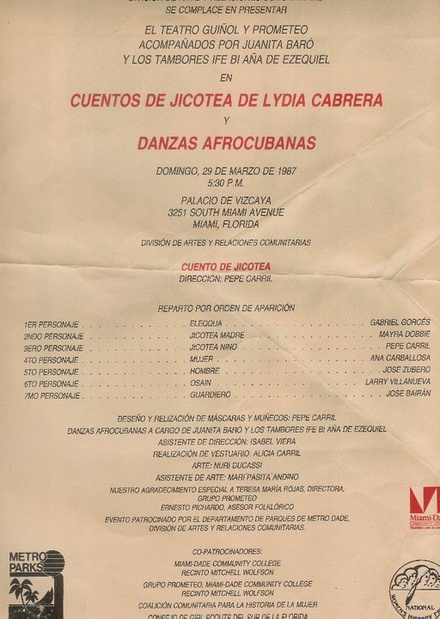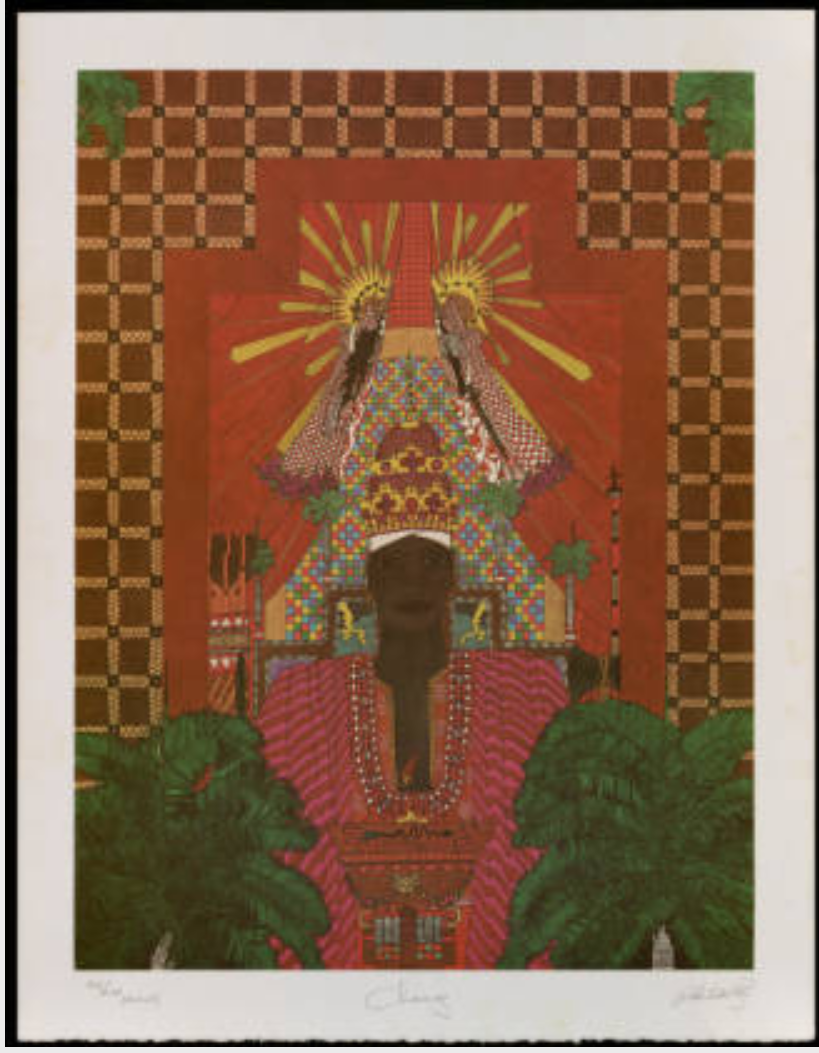A national 2012 census showed that out of over 11 million Cubans currently living on the island, around 1 million Cubans described themselves as Black (9.3% of the population) and 3 million considered themselves to be "mulatto" or "mestizo" (mixed-race). Outside of Cuba, Afro-Cuban refers to Cubans with African ancestry, a concept related but distinct from Afrocubanism, or Afro-Cuban as a socio-historical cultural movement distinguished by unique forms of religious practice such as Santería, Palo Monte, and the fraternal sect of Abakuá; music such as son, conga, mambo, chachachá, rumba, guaguancó, comparsa, and tumba francesa; and other art forms like theater, dance, and the visual arts. Note that, in Cuba, Black Cubans are not identified by the term Afro-Cuban. Studies of Afro-Cuban culture and identity also address the aftermath of the slave trade and colonization, as well as racism and its consequences in contemporary Cuban society and politics.
The resources included in this guide range from archival collections such as the Lydia Cabrera papers, oral histories, lectures, books, articles, databases, audiovisual materials, and online resources. Please note that the resources listed in this guide are not exhaustive.

Juan A. Villanueva
- Cuban Heritage & Spanish Language Collections Archivist
- j.villanueva5@umiami.edu
- (305) 284-4008

Amanda Moreno
- Esperanza Bravo de Varona Chair and Director of the Cuban Heritage Collection
- a.moreno8@umiami.edu
- (305) 284-5854
Jorge Castellanos papers Jorge Castellanos was an author and professor born in 1915 in Guantánamo, Cuba. Exiled to the United States by way of Jamaica in 1961, Castellanos was working as a history professor at Marygrove College in Detroit, Michigan, by 1962. After retirement, he continued to publish books on Cuban culture, most notably his series Cultura Afrocubana, co-authored with his daughter Isabel Castellanos, from 1988 to 1994.
Alberto del Pozo's Orichas Collection This collection consists of the series of drawings by Cuban-born artist Alberto del Pozo (1946-1992) of the deities of Afro-Cuban Santería. There are approximately 25 orichas in the Santería pantheon, 17 of which were depicted by del Pozo in this series. Santería refers to the Afro-Cuban practice of Lucumí or Regla de Ocha, a religious system originating with the African Yoruba people.
FLYER FOR THE THEATRICAL PRODUCTION, CUENTOS DE JICOTEA DE LYDIA CABRERA Y DANZAS AFROCUBANAS Archivo Digital de Teatro Cubano Cuban Theater Digital Archive.

Tumba francesa group in Havana, Cuba
"Tumba francesa (Habana en casa de Mimi Bacardí)"; Tumba Francesa is a traditional cultural dance and style of that emerged in the 18th century in Oriente, Cuba." Lydia Cabrera papers.
Collection CHC0231 - Vertical Files: Cuban Diaspora
- Item id365075 - Afro-Cubans-Miami
- Item id365076 - Afro-Cubans-Music
- Item id365077 - Afro-Cubans-Religions
- Item id365078 - Afro-Cubans-Santería
- Item id365805 - Culture, Afro-Cuban
Alejandro De La Fuente. A Nation for All. University of North Carolina Press, 2011.
Clealand, Danielle. The Power of Race in Cuba. New York: Oxford UP, 2017. Transgressing Boundaries: Studies in Black Politics and Black Communities.
Devyn Spence Benson. Antiracism in Cuba: The Unfinished Revolution. Chapel Hill: U of North Carolina, 2016. Envisioning Cuba.
La Rosa Corzo, Gabino. Runaway Slave Settlements in Cuba: Resistance and Repression. Chapel Hill: University of North Carolina Press, 2003.
Matibag, Eugenio. Afro-Cuban Religious Experience: Cultural Reflections in Narrative. Gainesville: University Press of Florida, 1996.
Moore, Robin D., and NetLibrary, Inc. Nationalizing Blackness: Afrocubanismo and Artistic Revolution in Havana, 1920-1940. Pittsburgh, Pa.: U of Pittsburgh, 1997. Pitt Latin American Ser.
Olupona, Jacob K., Rowland Abiodun. Ifá Divination, Knowledge, Power, and Performance. Bloomington: Indiana UP, 2016.
Perry, Marc D. Negro Soy Yo: Hip Hop and Raced Citizenship in Neoliberal Cuba. Durham: Duke UP, 2016.
Díaz, María Elena. The Virgin, the King, and the Royal Slaves of El Cobre: Negotiating Freedom in Colonial Cuba, 1670-1780. Stanford, Calif.: Stanford UP, 2000.
Gutiérrez, Mariela. An Ethnological Interpretation of the Afro-Cuban World of Lydia Cabrera (1900-1991). Lewiston: Edwin Mellen, 2008.
Howard, Philip A. Changing History: Afro-Cuban Cabildos and Societies of Color in the Nineteenth Century. Baton Rouge: Louisiana State University Press, 1998.
Jiménez Román, Miriam, and Juan Flores. The Afro-Latin@ Reader: History and Culture in the United States. Durham [N.C.]: Duke UP, 2010.
Lachatanere, R. El sistema religioso de los afrocubanos. La Habana: Editorial de Ciencias Sociales, 1992.
López Valdés, Rafael L. Africanos de Cuba. San Juan de Puerto Rico: Centro de Estudios Avanzados de Puerto Rico y el Caribe con la colaboración del Instituto de Cultura Puertorriqueña, 2002.
Montejo Arrechea, Carmen Victoria. Sociedades negras en Cuba, 1878-1960. La Habana: Editorial de Ciencias Sociales: Centro de Investigación y Desarrollo de la Cultura Cubana Juan Marinello, 2004.
Naranjo Orovio, Consuelo. Racismo e inmigración en Cuba en el siglo XIX. Madrid, Doce Calles: Fundación de Investigaciones Marxistas:, 1996.
Ortiz, Fernando. Cuban Counterpoint, Tobacco and Sugar. Durham: Duke University Press, 1995.
Ortiz, Fernando. Los Bailes Y El Teatro De Los Negros En El Folklore De Cuba. Madrid, Spain: Editorial Música Mundana Maqueda, 1998.
Palmié, Stephan. The Cooking of History: How Not to Study Afro-Cuban Religion. Chicago: U of Chicago, 2013.
Sawyer, Mark Q. Racial Politics in Post-Revolutionary Cuba. New York: Cambridge University Press, 2006.
Sosa, Enrique. Los Ñáñigos: Ensayo. Ciudad De La Habana, Cuba: Casa De Las Américas, 1982.
Valdeís, Yrmino. Ceremonias fúnebres de la santería Afrocubana: Ituto y honras de Egún. 1.th ed. Antiguo San Juan, Puerto Rico: Sociedad de Autores Libres, 1991.
Caribbean Newspapers, 1718-1876
Latin American Newspapers Series 1 & Series 2, 19th and 20th-century newspapers.
Voyages: The Trans-Atlantic Slave Trade: Digital memorial documenting the Trans-Atlantic Slave Trade.
| Slavery & Anti-Slavery: A Transnational Archive |
World Scholar: Latin America And The Caribbean A collection of primary source documents about Latin America and the Caribbean; academic journals and news feeds covering the region; reference articles and commentary; maps and statistics; audio and video; etc.
Feminism in Cuba: Nineteenth through Twentieth Century Archival Documents This collection, compiled by Dr. K. Lynn Stoner, includes Cuban sources that span the period from Cuban independence to the end of the Batista regime. The collection sheds light on Cuban feminism, women in politics, literature by Cuban women, and the legal status of Cuban women. The collection includes archives of Minerva a journal dedicated to women of color in Cuba
AfroCubaWeb: the African cultures in Cuba - Abakwa - Congo - Dahomey - Haiti - Yoruba - West Indies AfroCuba Web is an extensive online resource of news articles, essays, biographies, statistics, art, music, culture, politics, religion, links to websites. and more with the objective of educating about and preserving Afro-Cuban culture.
At the Crossroads: Afro-Cuban Orisha Arts in Miami Digital exhibition from HistoryMiami Museum.
Latin American Network Information Center (LANIC) is one of the largest guides for Latin American content on the Internet features thousands of links. See: African Diaspora in Latin America
Let’s Mambo!: Machito and His Afro-Cubans Library of Congress archival collection of Latin jazz musician and bandleader Machito, formally known as Francisco "Frank" Raúl Gutiérrez Grillo, (circa 1908-1984), active on the New York City jazz scene with his innovative band the Afro-Cubans from 1940 to the early 1980s, forming an influential legacy that includes salsa music and Afro-Cuban jazz. The collection contains approximately 150 manuscripts and published compositions and arrangements performed by the ensemble, as well as clippings, papers, a concert poster, and maracas.Yale University Library Archives and Manuscripts: Guide to the Cuban Slavery Collection. Official documents pertaining to slavery in Cuba, mostly from Matanzas, Cuba. Documents include death certificates for enslaved people, petitions for freedom from slavery, documentation of disputes, prisoner correspondence, and arrest warrants. Some death certificates specify the cause of death, the plantation or enslaver, and the enslaved person's origin in Africa. Compiled by Jana Krentz July 2020.
Christopher, Emma et al. They Are We. Brooklyn, NY: Icarus Films, 2015.
They are we is the story of a remarkable reunion that takes place 170 or so years after a family was driven apart by the ravages of the transatlantic slave trade. In Central Cuba, proud members of the Gangá-Longobá, a small Afro-Cuban ethnic group, have kept their unique heritage alive. Incredibly, through decades of brutal enslavement, independence wars, and then the denying of all religions after the revolution, they have retained a collection of distinct songs and dances that one of their ancestors brought from Africa as a slave. Each December 17th they still perform them at the San Lazaro ceremony. After a chance discovery while working in West Africa, director Emma Christopher spent two years showing a film of the Gangá-Longobá songs and dances to several thousand people across Sierra Leone. Eventually, in an isolated village with no road access, one man looked at another in joy and wonder as he watched a recording of the Gangá-Longobá songs and said, "They are we!" Then the villagers joined in with others of the Gangá-Longobá songs, still recognizing them clearly despite all the years of separation. Returning to Cuba, Emma showed her findings to the Gangá-Longobá. "We are not so alone anymore", said one of their number, woodcarver and artist Alfredo Duquesne. Later he would say that knowing where he came from "is divine". In early 2013, after the law changed allowing them to freely leave Cuba, a trip was at last made to visit Sierra Leone. It turned into a remarkable celebration, a rare recognition of the tenacity and resolve of one young girl who once made the awful journey from Africa to Cuba, but never let her memories of home die. They are we tells the story of the Gangá-Longobá and of the village their ancestor called home. It is the story of how, just very occasionally, a family separated by the slave trade can reunite for the good of all.
Catteau, Manuel, Queyrat, Jean, and Mann, Sharon. The Tumba Francesa. Paris, France: ZED, 2006. Living Cultures.
Sara Gomez: An Afro-Cuban Filmmaker. ArtMattan Productions, 2005.
Gómez Yera, Sara, and Tomás González Pérez. De Cierta Manera. La Habana, Cuba: Ediciones ICAIC, 2018. Colección Guión Cubano; 03.
P Rez Betancourt, Lvaro. Voices of the Orishas. Berkeley, Calif: Berkeley Media, 1994. Academic Video Online: Premium.
Rodríguez, Arsenio, and Justi Barreto. Arsenio Rodriguez Primitivo: Sonido, 1999.
Cruz, Celia, Merceditas Valdés, Bienvenido León, Eugenio De La Rosa, Coro Yoruba, Performer, and Tambores Batá De Jésus Pérez, Performer. Santero: Afro-Cuban Cult Music. Cuba]: Panart Records, 1960.
Orisha Aesthetics: A presentation by Michelle González Maldonado
Worldview, the Orichas, and Santería: A presentation by Mercedes Cros Sandoval
The Contradictions of Afrocubanismo Nationalism by Robin Moore
Afro-Cuban Religions: Race, Gender, and Politics. "Female Archetypes and Stereotypes of Santeria," Elaine Penagos and "Criminalization of Afro-Cuban Religions: Urban versus Rural," Thomas Terrill

